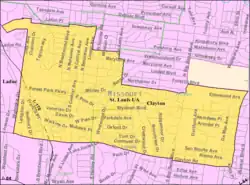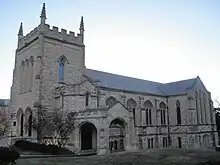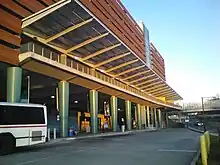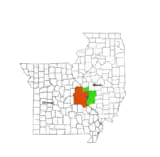Clayton, Missouri | |
|---|---|
 Clayton high-rises seen from the Moorlands | |
 Location in Missouri | |
 U.S. Census Map | |
| Coordinates: 38°38′40″N 90°19′49″W / 38.64444°N 90.33028°W | |
| Country | United States |
| State | Missouri |
| County | St. Louis |
| Settled | 1877 |
| Incorporated | 1913 |
| Government | |
| • Type | Mayor-council city |
| • Mayor | Michelle Harris |
| Area | |
| • Total | 2.51 sq mi (6.49 km2) |
| • Land | 2.51 sq mi (6.49 km2) |
| • Water | 0.00 sq mi (0.00 km2) |
| Elevation | 551 ft (168 m) |
| Population (2020) | |
| • Total | 17,355 |
| • Density | 6,919.9/sq mi (2,671.8/km2) |
| Time zone | UTC-6 (Central) |
| • Summer (DST) | UTC-5 (Central) |
| ZIP code | 63105 |
| Area code | 314 |
| FIPS code | 29-14572[3] |
| GNIS feature ID | 2393548[2] |
| Website | City of Clayton |
Clayton is a city in and the county seat of St. Louis County, Missouri, and borders the independent city of St. Louis. The population was 17,355 at the 2020 census.[4] Organized in 1877, the city was named after Ralph Clayton,[5] who donated the land for the St. Louis County courthouse.
Geography
Cityscape
The architecture of central Clayton reflects its economic activity and eras of growth. An impressive collection of mid-century modern low and high rise structures contrast with earlier mansions, stores and flats. Its surrounding residential neighborhoods maintain a dense, walkable character and were largely developed in the prewar era. These neighborhoods consist of brick walkups, apartment buildings, mansions and modest single family homes centered around several small business districts.
Neighborhoods
Claverach Park
Claverach Park is a residential neighborhood bounded by Wydown Boulevard on the north, Ridgemoor Drive and Big Bend Boulevard on the east, Clayton Road on the south, and Audubon Drive on the west. The neighborhood was planned in the early 1920s by Julius Pitzman who avoided a traditional street grid in favor of curvilinear streets lined by stately trees, one centrally located neighborhood park, and 9 pocket parks.[6] Oak Knoll Park, Clayton's second largest park and the former home to the St. Louis Academy of Science, is located in the neighborhood.
Clayshire
Clayshire is a suburban neighborhood bounded by Forest Park Parkway on the north, Interstate 170 on the east, Clayton Road on the south and the Ladue city limit to the west and includes the subdivision of Tanglewood. Unlike Clayton's denser prewar residential neighborhoods, Clayshire is characterized by a more postwar suburban development pattern. Neighborhood parks include Anderson Park, Clayshire Park, and Whitburn Park as well as a pedestrian underpass beneath I-170 that connects to Shaw Park. There is a small commercial area at the intersection of Clayton Road and Brentwood Boulevard.
Davis Place

A large residential neighborhood, Davis Place is characterized primarily by single family homes with some apartment buildings along Hanley Road and Brentwood Boulevard. Its boundaries are Forest Park Parkway on the north, Hanley Road on the east, Clayton Road on the south, and Brentwood Boulevard on the west. The neighborhood includes the subdivisions Country Club Place, Country Club Court, and Remmerts. Davis Place is also home to the Shops of Clayton commercial corridor along Clayton Road.
DeMun
Part of the Hi-Pointe–DeMun Historic District, DeMun is primarily a residential neighborhood on the eastern edge of Clayton. It is a dense and walkable neighborhood characterized by brick and limestone prewar apartment blocks, single family homes and small commercial areas centered around DeMun Avenue and Clayton Road. The neighborhood is also home to Concordia Seminary, the South Campus of Washington University, and three public parks (Concordia, DeMun, and Henry Wright).
The boundaries of DeMun in Clayton are Concordia Seminary's northern property line and Northwood Avenue, the St. Louis city limit to the east, Clayton Road to the south, and Big Bend Boulevard to the west.
Downtown Clayton

Downtown Clayton is the seat of St. Louis County government and home to its headquarters campus. In addition, downtown Clayton is home to three of the St. Louis region's seven Fortune 500 headquarters; Centene Corporation, Graybar, and Olin Corporation.[7] Commerce Bank, the Regional Business Council and the St. Louis Club are located in the neighborhood as well. Downtown Clayton is known for its many restaurants and cafes and hosts the St. Louis Art Fair along its streets during September each year.[8] Recently, the neighborhood has entered a period of significant redevelopment and new construction with the opening of the Two Twelve Clayton and Ceylon apartment buildings in 2017, Centene Plaza C in 2019, and the groundbreaking of the two tower Forsyth Pointe development in 2020.[9] As of 2022, downtown Clayton had seven projects, worth approximately $600 million, either in development or under construction.[9]
The boundaries of downtown Clayton are Maryland Avenue on the north, the University City limit on the east, Forest Park Parkway on the south, and Brentwood Boulevard on the west. The neighborhood is served by MetroLink via the Blue Line at the Clayton and Forsyth stations.
Moorlands
Like Clayton's other urban, walkable neighborhoods, the Moorlands is characterized by large, prewar masonry apartment buildings and single family homes with high-rise apartment buildings along Hanley Road and a small commercial district at the intersection of Hanley and Wydown Boulevard. Most of the single family homes are concentrated east of Glenridge Drive while most of the apartment buildings are concentrated to the west. The neighborhood's boundaries are Wydown Boulevard on the north, Audubon Drive on the east, Clayton Road on the south, and Hanley Road on the west.
North Clayton
North Clayton is a dense, walkable set of neighborhoods that encompass all of Clayton north of Maryland Avenue. The area is mostly made up of densely packed single family homes with office, apartment and condo buildings located primarily between Meramec Avenue and Brentwood Boulevard. Commercial corridors include Meramec and Maryland avenues. The neighborhood is home to Kol Rinah synagogue, St. Joseph Catholic Church, the Mid County branch of the St. Louis County Library, and Centene's corporate training center. Neighborhood parks include Taylor Park and Hanley Park which includes the historic Hanley House.
Subdivisions within North Clayton include the Bemiston additions, Clayton Gardens, Colonial Park, Hanley Place, and Maryland Terrace. Its boundaries to the north and east are the city limits with University City, its southern boundary is Maryland Avenue, and its western boundary is the Ladue city limit.
Other neighborhoods
Other neighborhoods and subdivisions within Clayton include Brentmoor and Brentmoor Park, Carrswold, Ellenwood, Forest Ridge, Hillcrest, Parkside, Skinker Heights, Southmoor, Tesson, Tuscany Park, Wydown Forest, and Wydown Terrace.
Demographics
In the St. Louis region, Clayton is well known for housing a wealthy, educated, professional, and often dual-income population.
| Census | Pop. | Note | %± |
|---|---|---|---|
| 1890 | 402 | — | |
| 1920 | 3,028 | — | |
| 1930 | 9,613 | 217.5% | |
| 1940 | 13,069 | 36.0% | |
| 1950 | 16,035 | 22.7% | |
| 1960 | 15,245 | −4.9% | |
| 1970 | 16,100 | 5.6% | |
| 1980 | 14,219 | −11.7% | |
| 1990 | 13,874 | −2.4% | |
| 2000 | 12,825 | −7.6% | |
| 2010 | 15,939 | 24.3% | |
| 2020 | 17,355 | 8.9% | |
| U.S. Decennial Census[10] | |||
2020 census
The 2020 United States census[11] counted 17,355 people, 5,587 households, and 3,275 families in Clayton. The population density was 6,914.3 per square mile (2,674.1/km2). There were 6,061 housing units at an average density of 2,414.7 per square mile (933.9/km2). The racial makeup was 71.37% (12,386) white, 8.07% (1,400) black or African-American, 0.16% (28) Native American, 12.88% (2,235) Asian, 0.01% (2) Pacific Islander, 1.04% (181) from other races, and 6.47% (1,123) from two or more races. Hispanic or Latino of any race was 3.6% (609) of the population.
Of the 5,587 households, 28.8% had children under the age of 18; 50.2% were married couples living together; 27.8% had a female householder with no husband present. Of all households, 34.5% consisted of individuals and 10.4% had someone living alone who was 65 years of age or older. The average household size was 2.2 and the average family size was 2.9.
16.8% of the population was under the age of 18, 25.4% from 18 to 24, 21.7% from 25 to 44, 21.3% from 45 to 64, and 11.3% who were 65 years of age or older. The median age was 29.5 years. For every 100 females, the population had 97.9 males. For every 100 females ages 18 and older, there were 96.2 males.
The 2016-2020 5-year American Community Survey[12] estimates show that the median household income was $108,387 (with a margin of error of +/- $9,440) and the median family income was $157,621 (+/- $21,434). Males had a median income of $54,146 (+/- $10,043) versus $36,023 (+/- $10,664) for females. The median income for those above 16 years old was $42,336 (+/- $3,903). Approximately, 6.2% of families and 8.0% of the population were below the poverty line, including 5.2% of those under the age of 18 and 2.8% of those ages 65 or over.
2010 census
As of the census[13] of 2010, there were 15,939 people, 5,322 households, and 2,921 families living in the city. The population density was 6,427.0 inhabitants per square mile (2,481.5/km2). There were 6,321 housing units at an average density of 2,548.8 per square mile (984.1/km2). The racial makeup of the city was 78.0% White, 8.2% African American, 0.2% Native American, 10.8% Asian, 0.4% from other races, and 2.4% from two or more races. Hispanic or Latino of any race were 3.1% of the population.
There were 5,322 households, of which 26.3% had children under the age of 18 living with them, 46.3% were married couples living together, 6.7% had a female householder with no husband present, 1.9% had a male householder with no wife present, and 45.1% were non-families. 37.5% of all households were made up of individuals, and 11.2% had someone living alone who was 65 years of age or older. The average household size was 2.12 and the average family size was 2.86.
The median age in the city was 29.2 years. 15.8% of residents were under the age of 18; 27.6% were between the ages of 18 and 24; 23.3% were from 25 to 44; 21.6% were from 45 to 64; and 11.8% were 65 years of age or older. The gender makeup of the city was 50.9% male and 49.1% female.
2000 census
As of the census[3] of 2000, there were 12,825 people, 5,370 households, and 2,797 families living in the city. The population density was 5,164.4 inhabitants per square mile (1,994.0/km2). There were 5,852 housing units at an average density of 2,356.5 per square mile (909.8/km2). The racial makeup of the city was 84.94% White, 7.77% Black or African American, 0.12% Native American, 5.62% Asian, 0.03% Pacific Islander, 0.29% from other races, and 1.22% from two or more races. Hispanic or Latino of any race were 1.49% of the population.
There were 5,370 households, out of which 25.9% had children under the age of 18 living with them, 43.4% were married couples living together, 6.7% had a female householder with no husband present, and 47.9% were non-families. 40.4% of all households were made up of individuals, and 11.8% had someone living alone who was 65 years of age or older. The average household size was 2.09 and the average family size was 2.90.
In the city, the population was spread out, with 20.1% under the age of 18, 10.7% from 18 to 24, 32.3% from 25 to 44, 22.6% from 45 to 64, and 14.3% who were 65 years of age or older. The median age was 37 years. For every 100 females, there were 100.5 males. For every 100 females age 18 and over, there were 98.0 males.
The median income for a household in the city was $64,184, and the median income for a family was $107,346. Males had a median income of $64,737 versus $42,757 for females. The per capita income for the city was $48,055. About 5.0% of families and 7.7% of the population were below the poverty line, including 9.5% of those under age 18 and 3.2% of those age 65 or over.
Government
Clayton is governed via a six-member board of aldermen and a mayor. Aldermen are elected from one of three wards with each electing two members. The mayor is elected in a citywide vote. A city clerk is appointed by the Mayor and Board of Aldermen.[14][15] Police services are provided by the Clayton Police Department, led by Chief Mark J. Smith,[16] with fire and rescue services provided by the Clayton Fire Department, led by Chief Ernie Rhodes.[17]
Currently the mayor of Clayton is Michelle Harris and the Board of Aldermen includes:
| Clayton Board of Aldermen | ||
|---|---|---|
| Ward 1 | Ward 2 | Ward 3 |
| Richard Lintz | Ira Berkowitz | Bridget McAndrew |
| Becky Patel | Susan Buse | Gary Feder |
| Clayton Mayor & Board of Aldermen | ||
Because of its status as the St. Louis County seat, Clayton is home to the St. Louis County Council, the St. Louis County courts, the Buzz Westfall Justice Center, and the St. Louis County Police headquarters.
Economy
Clayton is one of the St. Louis region's primary business districts and the second largest after downtown St. Louis. The city boasts roughly 46,000 daytime employees[18] and is home to a large and diverse group of the region's Fortune 500 headquarters, blue chip companies, law firms, and banks.
In addition to the largest employers listed below, other companies that call Clayton home or have operations there include Bank of America, Barry-Wehmiller, Cassidy Turley, Cushman & Wakefield, Graybar, Olin, Stifel, and Straub's Markets. The unemployment rate in 2021 was 1.3%.[19]
Largest employers
| # | Employer | # of Employees ‡ |
|---|---|---|
| 1 | Centene | 2,879 |
| 2 | St. Louis County | 1,121 |
| 3 | Enterprise Holdings | 1,071 |
| 4 | Washington University | 809 |
| 5 | Caleres | 588 |
| 6 | Commerce Bank | 536 |
| 7 | School District of Clayton | 454 |
| 8 | Husch Blackwell | 383 |
| 9 | Armstrong Teasdale | 376 |
| 10 | Moneta Group, LLC | 367 |
| ‡ City of Clayton Comprehensive Annual Financial Report[18] | ||
Transportation
Public transportation

Clayton is served by the Blue Line of the St. Louis region's MetroLink light rail system. The city has two stations: the Forsyth station, which serves downtown Clayton but is within city limits of University City; and Clayton. Metro Transit also operates the Clayton Transit Center on Shaw Park Drive, which connects the Clayton light rail station with multiple MetroBus routes and paratransit services.
Major roads and highways
Major arterial routes in Clayton include Big Bend Boulevard, Brentwood Boulevard, Clayton Road, Forest Park Parkway, Hanley Road, and Interstate 170. Forsyth Boulevard (which changes to Old Bonhomme between North Clayton and University City) was at one time an ancient Native American trail and was part of the route of the 1904 Olympic marathon.[20] Other primary routes in the city include Maryland Avenue and Wydown Boulevard, the latter of which was named a Great Street by the American Planning Association in 2010.[21]
Education
Higher education

The city is home to Fontbonne University and Concordia Seminary of the Lutheran Church–Missouri Synod. A portion of Washington University's Danforth Campus, the South 40, is located in eastern Clayton and primarily consists of student housing.[22] Washington University's West Campus is located in downtown Clayton and houses offices for the library, information technology, and other university departments.[23] In 2007, Washington University acquired its South Campus in the DeMun neighborhood which is used primarily by intramural and club sports programs in addition to community theater groups.[24]
Primary and secondary schools
The city's public schools are operated by the School District of Clayton. Its three public elementary schools are Glenridge Elementary School in the Moorlands neighborhood, Captain Elementary School in the DeMun neighborhood, and Meramec Elementary School in Davis Place. These schools feed into Wydown Middle School on Wydown Boulevard which in turn feeds into Clayton High School, next to Shaw Park near downtown Clayton. In 2021 the district's enrollment was 2,412 students.[19]
Several of Clayton's elementary schools have been closed or repurposed. Gay School is now the Clayton Family Center; Maryland School has been repurposed into a Centene training center;[25] DeMun School burned in a fire and was replaced by Ralph M. Captain Elementary; and, after Brown v. Board of Education abolished segregated schools, Crispus Attucks School in downtown Clayton was demolished and replaced with an office building.[26]
Public libraries
St. Louis County Library operates the Mid-County Branch in Clayton, which was rebuilt and reopened on September 4, 2020.[27][28][29]
Parks and recreation
At 30-acres, Shaw Park is the largest park in Clayton. The park hosts an Olympic-sized swimming pool, a kiddie pool, a diving pool with three platforms, 11 tennis courts, an ice rink, a baseball and soccer field, volleyball courts, handball courts, a sensory garden, a trail, a playground, and multiple pavilions. The park hosts Clayton's Independence Day celebration and the Taste of Clayton food festival. The city's second-largest park is the 14.5-acre Oak Knoll Park which was once home to the St. Louis area's Academy of Science before the organization moved to Forest Park and became the St. Louis Science Center.
Clayton is home to several additional neighborhood parks that include Anderson Park, Clayshire Park, Concordia Park, DeMun Park, Hanley Park, Henry Wright Park, Maryland Avenue Park, Taylor Park, Whitburn Park, and Wydown Park.
Additionally, the city is served by the Great Rivers Greenway District's Centennial Greenway, which enters the city on the north near Gay Avenue and ends in Shaw Park. Other routes with dedicated bicycle lanes include Maryland Avenue and Wydown Boulevard, the latter of which connects Clayton to St. Louis' Forest Park.
References
- ↑ "ArcGIS REST Services Directory". United States Census Bureau. Retrieved August 28, 2022.
- 1 2 U.S. Geological Survey Geographic Names Information System: Clayton, Missouri
- 1 2 "U.S. Census website". United States Census Bureau. Retrieved January 31, 2008.
- ↑ Bureau, US Census. "2020 Census Results". Census.gov. Retrieved October 2, 2022.
- ↑ Eaton, David Wolfe (1918). How Missouri Counties, Towns and Streams Were Named. The State Historical Society of Missouri. p. 359.
- ↑ "Our History". Claverach Park. March 3, 2011. Retrieved November 10, 2022.
- ↑ "Seven St. Louis-area companies named in 2022 Fortune 500 list". FOX 2. May 26, 2022. Retrieved November 10, 2022.
- ↑ "Saint Louis Art Fair - Home". saintlouisartfair.com. Retrieved November 14, 2022.
- 1 2 Kukuljan, Steph. "High-rises are booming in Clayton, but will downtown lose its charm?". STLtoday.com. Retrieved November 10, 2022.
- ↑ United States Census Bureau. "Census of Population and Housing". Retrieved November 26, 2014.
- ↑ "Explore Census Data". data.census.gov. Retrieved December 17, 2023.
- ↑ "Explore Census Data". data.census.gov. Retrieved December 17, 2023.
- ↑ "U.S. Census website". United States Census Bureau. Retrieved July 8, 2012.
- ↑ "Mayor & Board Of Aldermen". claytonmo.gov. Retrieved May 27, 2022.
- ↑ "City Clerk". claytonmo.gov. Retrieved May 27, 2022.
- ↑ "Police | City of Clayton, MO". www.claytonmo.gov. Retrieved November 14, 2022.
- ↑ "Fire | City of Clayton, MO". www.claytonmo.gov. Retrieved November 14, 2022.
- 1 2 "City of Clayton CAFR". City of Clayton. September 30, 2021. p. 102. Retrieved November 14, 2022.
- 1 2 "City of Clayton CAFR". City of Clayton. September 30, 2021. p. 101. Retrieved November 14, 2022.
- ↑ Holleman, Joe. "Spotlight: Lone marker notes 1904 Olympic marathon route, but who put it up?". STLtoday.com. Retrieved November 14, 2022.
- ↑ "Wydown Boulevard: Clayton, Missouri". American Planning Association. Retrieved November 14, 2022.
- ↑ Teresa (October 29, 2018). "South 40 Residential Colleges". Students. Retrieved November 14, 2022.
- ↑ "West Campus". Washington University in St. Louis. Retrieved November 14, 2022.
- ↑ "South Campus". Washington University in St. Louis. Retrieved November 14, 2022.
- ↑ Post-Dispatch, Samantha Liss St Louis. "Centene to buy Maryland School in Clayton". STLtoday.com. Retrieved November 14, 2022.
- ↑ Post-Dispatch, Richard H. Weiss Special to the. "Clayton was once home to a thriving African American community". STLtoday.com. Retrieved November 14, 2022.
- ↑ "Clayton city, Missouri Archived 2009-09-06 at the Wayback Machine." U.S. Census Bureau. Retrieved on June 13, 2009.
- ↑ "Mid-County Branch Archived 2009-07-29 at the Wayback Machine." St. Louis County Library. Retrieved on August 18, 2009.
- ↑ Henderson, Jane. "New Mid-County library to open Sept. 4 in Clayton". STLtoday.com. Retrieved October 19, 2020.


